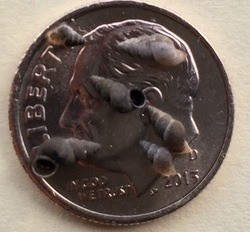With no natural predators and the ability to clone themselves, tiny New Zealand mudsnails are perhaps the perfectly designed invasive species – and that’s why King County ecologists urge the public to take simple precautions and help stop their spread.
First discovered five years ago in Thornton Creek, which flows into Lake Washington, the tiny snails have now been confirmed in four additional streams within the watershed: Kelsey, Thornton and McAleer creeks, and most recently May Creek.
Ecologists studying native cutthroat trout in Lake Washington have discovered that mudsnails eaten by the fish pass through undigested, meaning the trout aren’t getting any nutritional value by eating the mollusks.
“While we don’t yet know their full potential impact, we do know that New Zealand mudsnails are likely to disrupt the ecosystem’s food chain by crowding out or outcompeting the native aquatic insects many animals depend on,” said Sally Abella, lead limnologist for the Freshwater Assessment Group with the King County Department of Natural Resources and Parks (DNRP).
“There is no way to get rid of them once they are in a stream system,” said Jo Wilhelm, an environmental scientist with the DNRP’s Watershed and Ecological Assessment Team. “Now that they are here, the best outcome we can hope for is to slow their spread and limit their range to as few streams as possible.”
One of the big challenges in dealing with an invasion of New Zealand mudsnails is their small size. A dozen or more full-grown snails can easily fit atop a penny. What might look like miniscule pebbles or even grains of sand on a boot’s sole or other items that have been in an infested stream could actually be New Zealand mudsnails which could then be unknowingly transported to new areas.
People who enter streams in the Lake Washington watershed are encouraged to follow a few simple steps that will reduce the likelihood of spreading mudsnails elsewhere:
• Avoid transferring anything wet from stream to stream, including boots, waders or any other gear.
• Clean off mud and other debris after a trip to a stream.
• Thoroughly dry or freeze any equipment that’s been in a stream before entering another stream.
• Dogs and other pets should not be allowed into streams with known New Zealand mudsnail infestations.
Visit King County’s New Zealand mudsnails page for identification, cleaning and other tips so their spread can be minimized.
People who frequent other streams in the Lake Washington watershed are encouraged to report any possible New Zealand mudsnail infestations tosally.abella@kingcounty.gov.


